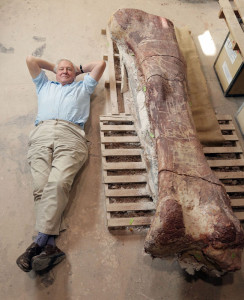Must Farm, the archaeological site that uncovered a Bronze Age village and boats in Cambridgeshire is also a working quarry (for the nearby brick works). A pleisosaur has been dug out of what is known as the Oxford Clay, a geological strata known for containing small or broken fossilised remains of creatures. The pleisosaur is now in the Oxford University Natural History Museum and is 5.5m in length, having been reassembled from 600 bone fragment – see for example www.bbc.co.uk/news/uk-england-cambridgeshire-35380223 ….
A new species of carnivorous dinosaur, the Dracoraptor, was unearthed on a beach at Penarth near Cardiff, in South Wales. It was about the size of a large dog and may actually have been a juvenile of a bigger animal. However, it dates back 200 million years ago – at the very beginning of the Jurassic (see for example www.dinosaurtheory.com/scaling.html and http://phys.org/print372500013.html. The findings were published in January's issue of PLoS One online journal.
Meanwhile, there is more on dinosaurs at www.xearththeory.com/dinosaurs/ .. but be warned, this is an Expanding Earth web site. Stephen Hurrell is one of the leading proponents of this theory and he is far from impressed by the mainstream view that dinosaurs are closely related to birds and have a much lower bone density than mammals. He ask – how do you eat a skip full of food every day with chewing? How do you walk on tip toe when you are the length of four London red buses? How do you have sex when you weigh 70 tones? – all questions uniformitarians gloss over without an adequate explanation, he says. Have paeontologists been too quick to leap on similarities between birds and dinosaurs in order to neutralise the problem of huge size and gravity (or the square cube law)? There are a lot of sites out there that seem quite comfortable with the idea that dinosaurs had a lower bone density than mammals although even then they would still appear to contradict the square cube law. Recently, an American sportsman of note was roundly condemned on social media and message boards etc for claiming there was less gravity when the dinosaurs were lumbering about on the surface of the Earth. The criticism was like a great wave of noise in order to drown out the idea. Therefore it is interesting to note that Hurrell introduces his readers to the Electric Universe explanation for less gravity – something which mainstream would not dare consider. He asks if gravity is actually an electromagnetic force and can gravity change (go up or go down). If gravity varies the weight of animals on the planet may also vary.
Meanwhile, there was a BBC TV one off documentary fronted by David Attenborough at 6.30pm on January 24th (available on iplayer) 'Attenborough and the Great Dinosaur' (which had a different title in the US, 'Raising the Great Dinosaur') – see for example http://phys.org/news/2016-01-fossil-dinosaur-huge.html
 and here he is next to a thigh bone of the beast.
and here he is next to a thigh bone of the beast.
